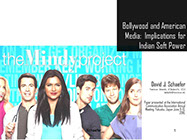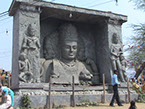ICA 2016 Panel:  The Power of Bollywood: Prospects for Indian Soft Power in the Asian Century (Fukuoka, Japan)
The Power of Bollywood: Prospects for Indian Soft Power in the Asian Century (Fukuoka, Japan)
Paper Titles and Abstracts
1) Bollywood and American Media: Implications for Indian Soft Power, David J. Schaefer,
Franciscan University of Steubenville, Ohio, U.S.A.
dschaefer@franciscan.edu
As noted by many commentators (Thussu, 2015, 2013; Roy, 2012; Gehlawat, 2015; Schaefer & Karan, 2013), the government of India embarked on a mission in the mid-2000s to promote the subcontinent’s soft power – its movies, music, brands, and culture – in order to facilitate global economic and political clout. Such activities included the promotion of movies, star tours, cultural events, international film shoots, and the creation of web sites. These efforts have largely been successful in culturally proximate regions of the world (i.e., south-east Asia, the middle-east, and diasporic pockets in the West), while those in non-culturally affiliated areas like North America have been slow to warm up to indigenous Indian media. For example, few Bollywood movies have earned more than several-million dollars in the North American market, well below the average take for a Hollywood or British production. For non-Indian North Americans, Bollywood is simply one more choice in an overcrowded multicultural smörgåsbord that includes Japanese Anime and videogames, South Korean pop music, British comedies, Mexican Telenovelas, American Hip Hop, and German thrash metal, among other choices. However, the past few years have witnessed a somewhat dramatic turn in the visibility of Indians or those of Indian heritage in American film and television. In this paper, I present a case study of several prominent Indians and Indian-Americans who have developed successful personae in American media (e.g., Mindy Kaling). I also examine the implications of Bollywood star Priyanka Chopra’s recent success playing the lead role in ABC’s prime-time fall 2015 drama Quantico, a first for any Indian star. I conclude by theorizing how cultural hybridization has the potential to shift control of the global image of India away from the subcontinent.
2) Dhoom, Rang Fab, Bombay Café: Bollywood Media Assemblages in Singapore, Anjali Gera Roy, Indian Institute of Technology, Kharagpur, West Bengal, India. Agera_2005@yahoo.com
Ashish Rajadhyaksha (2003), in the Bollywoodization of Indian cinema, called attention to the emergence of an entire culture industry from ringtones to fashions centered on cinema at the turn of the twenty first century that came to signify Bollywood in the global imaginary. Following the formalist or interpretative analysis of newly discovered popular Hindi cinematic texts in the last two decades or so, film theory has turned to unpacking the uses and gratifications of “Bollywood” extending beyond the cinematic. It focuses in particular on media assemblages that relocate the visual economy of the cinematic text to other visual texts and economies such as aural, tactile, and even olfactory to reproduce sub-continental “sensuous geographies” through viewing and watching Bollywood films in multiple exhibition spaces. These studies reveal the pleasure of Bollywood cinema to be part of a complex desiring machine in which the meanings produced by the cinematic narrative function in a complex system of signification formed through the intersection of discursive with material practices. They engage with the practice of cinema going in India and in the diasporas by locating them in a complex media assemblage through which the cinematic text acquires social centrality. For Singaporean populations, watching Indian movies is imbricated with a wide range of material practices – music, dance, art, fashions, food, advertising and so on – through which complex meanings are produced. Viewing cinema as “a socially embedded set of practices”, this paper will examine multiple spaces produced by Indian cinema to demonstrate the social centrality of Indian cinema for Singapore’s diverse ethnicities.
3) Stumbling to Bollywood’s power: A critical analysis of Hollywood’s (mis)adventures in the Indian culture market, Azmat Rasul (Presenter), azmatrasul@gmail.com, Stephen D. McDowell, PhD , Defne Bilir, PhD., Barbara Robinson, PhD, Mudassir Mukhtar. Florida State University, U.S.A.
The nature of film industry is intrinsically different from other media (Bagdikian, 2004; Bettig & Hall, 2003). It is relatively free from the governmental regulation and heavily relies on attracting viewers for generating revenues. Wasko (2004) argues that film industry should be considered as “commodities produced and distributed within a capitalist industrial structure” (p. 132). Thus, film industries tend to produce cultural commodities that could ensure profit maximization using synergistic practices, mutual cooperation, and coproductions across the globe. By 2009, the temptation to enter into the burgeoning Indian film market was so irresistible that Jim Gianopulos, co-chairman of Fox Filmed Entertainment, made a beeline for Shahrukh Khan and Karan Johar – the most significant players in Bollywood – rather than the usual Hollywood stars at that year’s Golden Globe Awards ceremony. In an interview with the New York Times, Gianopulos urged Hollywood studios to be humble and cooperate with the Mumbai-based Indian film industry on equal terms if they want to thrive in a movie-mad country like India (Chopra, 2009). This avid gesticulation heralds the beginning of a symbiotic relationship between the two behemoth industries; since 2007, major Hollywood studios have been engaged in coproductions with Bollywood, relying on Indian actors and directors instead of Hollywood stars. The developing relationship between the two major actors of the motion picture industry – Hollywood and Bollywood – raises important questions regarding the political economy of the global film industry. Global operations of large movie industries lead to concentration of ownership and power. Several studies have discussed the patterns of concentration and consolidation in the film industry in the United States and Europe and have criticized the takeover of the culture industry by a few large transnational, transindustrial corporations. However, Hollywood's engagement with Bollywood is a recent phenomenon, beginning with the release of Saawariya by Sony in November 2007. The objective of this paper is to examine the nature and magnitude of investments by Hollywood majors in Bollywood projects using a critical political economic approach. This paper seeks to answer important questions related to wealth, power, and ideology. Because the objective of the movie industry is market dominance through cooperation and concentration, it is important to look into the political and economic repercussions of joint ventures between global entertainment industries. Critical political economy will be used as analytical strategy and conceptual framework to evaluate the consequences of increasing cooperation between Hollywood film studios and the Indian film industry.
4) The Political Power of Indian Cinema- An Analysis of “Political” Bollywood films, Kavita Karan and Namrate Sathe, School of Journalism , Southern Illinois University, Carbondale, IL, USA. kavitak@siu.edu
From Leader (1964) to Raajneeti (2010), political narratives have been popular in Indian cinema for many decades, and in recent years several films with political content, youth power and political issues have become popular. Bollywood has captured political themes, political movements, political moments and political uprisings in Indian cinema, as well as created a platform for stars to turn to politics. Researches have focused on the dynamics of films and politicians within the framework of the politics of South India as in Indian cinema the “screen-constructed popular image of the star” facilitates “politicisability” of the film stars. This case study, through an in-depth analysis of ten “political” Bollywood films, not only engages the construction of political leaders through the cinematic frames, but also studies the power of the political content of Indian cinema in drawing attention to political issues, leadership, characteristics of politicians, political movements, politics and youth, and exposure of social issues like high prices, corruption, criminalization, feudalism, and other political problems, some of which have been discussed in earlier studies. The study also examines the techniques of marketing by political parties as they seek out actors as candidates, and for campaigning and its possible impact on youth. As the global power of Indian cinema expands, this research focuses on the extent to which these films raise the political consciousness among youth, something that political parties are striving to achieve to increase political participation and voting among the youth not only in India, but also across the world.
5) Networked Bollywood: Award-winning families? Sunitha Chitrapu, Sophia Polytechnic, Mumbai, India. schitrap@gmail.com
Networks are an important feature of work in film industries (Cattani and Ferriani 2008), more so in Mumbai’s Hindi film industry in which they have been compared to the tangled growth of a banyan tree (Lorenzen and Taeube, 2010). The “informal social relations” between media workers at the core create a close-knit network (Lorenzen and Taeube, 2007). The effect of these informal networks is an exclusion of those who are not privileged (Lee, 2011). This paper empirically examines the award winners at the National, Screen and Filmfare Awards of the last five years to explore family and institutional connections between winners to understand the extent to which networks affect work in Mumbai’s film industry.
References
Appadurai, A. (1996) Modernity at large: Cultural dimension of globalization. Minneapolis: Minnesota.
Bagdikian, B. H. (2004). The new media monopoly. Boston: Beacon Press.
Bettig, R. V., & Hall, J. L. (2003). Big media, big money: Cultural texts and political economics. Boston: Rowman & Littlefield.
Cattani, Gino, and Simone Ferriani. "A Core/Periphery Perspective on Individual Creative Performance: Social Networks and Cinematic Achievements in the Hollywood Film Industry." Organization Science 19, no. 6 (2008): 824-44.
Chopra, A. (2009, March 20). Stumbling toward Bollywood. New York Times, p. AR18.
Dickey, S. (1993). The Politics of Adulation: Cinema and the Production of Politicians in South India. Journal of South Asian Studies. Vol. 52, No. 2. 340-372.
Ganti, T. (2013). Bollywood: A guidebook to popular Hindi cinema. NY: Routledge.
Gehlawat, A. (2015). Twenty-first century Bollywood. London: Routledge.
Gopal, S. and Moorti, S. (2008). Global Bollywood: Travels of Hindi song and dance. Minneapolis: University of Minneapolis Press.
Joshi, P. (2015) India’s Bollywood: A Public’s Fantasy. New York. Columbia University Press.
 ICA 2016 Panel: The Power of Bollywood: Prospects for Indian Soft Power in the Asian Century
ICA 2016 Panel: The Power of Bollywood: Prospects for Indian Soft Power in the Asian Century
Presenters
Sunitha Chitrapu received her PhD in Mass Communication from Indiana University, Bloomington, US in 2008. Her research interests include the economics of media production and Indian film industries. Her publications include book chapters in Reception and Audience Studies edited by Radhika Parameswaran (Wiley-Blackwell, forthcoming in 2013), Bollywood and Globalisation: The Global Power of Popular Hindi Cinema edited by David Schaefer and Kavita Karan (Routledge, 2013) and The Magic of Bollywood: At Home and Abroad edited by Anjali G Roy (Sage, 2012). She is currently a lecturer in the Social Communications Media Department, Sophia Polytechnic, Mumbai.
Kavita Karan is an associate professor in the School of Journalism at Southern Illinois University, Carbondale, United States. She graduated from The London School of Economics and Political Science, specializing in political communication. Her teaching and research interests include advertising and marketing, Indian film studies, new communication technologies, political and health communication. She has published several articles in journals and chapters in books. Her edited and co-edited books include: Cyber Communities in Rural Asia: A study of Seven Countries (2004), Commercializing Women: Images of Women In Asia (2008; co-edited with Katherine T. Frith); 2001 Singapore General Elections: Study of Media Politics and People (2011; co-edited with Eddie ,C.Y. Kuo and Lee Shu Hui); Information Policies in Asia: Development of Indicators. UNESCO (2011) and Globalization and Bollywood: The Global Power of Popular Hindi Cinema (2013; co-edited with David Schaefer).
Azmat Rasul is an Assistant Professor at Florida State University, and is engaged in research projects on the political economy of the motion picture industry, and communication policy and regulation. Dr. Rasul has authored two books and published research papers in various journals. Rasul has been an Erasmus Mundus scholar at the University of Aarhus, Denmark, and University van Amsterdam, the Netherlands where he worked on media and cultural diversity in Europe and the effects of infotainment on politics.
Anjali Gera Roy is a Professor of English in the Department of Humanities and Social Sciences at the Indian Institute of Technology (IIT) Kharagpur, West Bengal, India. She has done extensive research on various aspects of Bollywood, especially on the relationship between global musical flows and identity formation, as part of a Senior Research Fellowship of the Indo-Canadian Shastri Institute in 2007, as well as on Bollywood’s transnational flows at the Asia Research Institute National University of Singapore in 2008–2009. She has published essays in literary, film, and cultural studies and also has edited several books. She has recently co-edited with Nandi Bhatia a volume of essays, Partitioned Lives: Narratives of Home, Displacement and Resettlement (2008), on the Indian Partition of 1947. Her book on Bhangra’s global flows, Bhangra Moves: From Ludhiana to London and Beyond was published in 2010. She is also the editor of The magic of Bollywood: At home and abroad (2012; SAGE).
David J. Schaefer (PhD, The Ohio State University, USA, 2001) is Professor and Chair in the Department of Communication Arts at Franciscan University of Steubenville, Ohio, USA. His research interests include Indian cinema, globalization and public sphere theory, media literacy, and online communication, on which he has written numerous conference papers, journal articles, and book chapters. He is a member of the Phi Kappa Phi National Honor Society, the International Communication Association, the Communication Institute for Online Scholarship, and the Asian Media Information and Communication Centre, and serves on the Board of Directors for Urban Mission Ministries. In addition, he was awarded a Fulbright lecturing–research grant to Singapore for 2004–5 to study media literacy trends in Asia. He is the editor of the book Bollywood and Globalization: The Power of Popular Hindi Cinema (Routledge, 2013; co-edited with Kavita Karan)
Daya Thussu is Professor of International Communication and Co-Director of India Media Centre at the University of Westminster in London. Author or editor of more than a dozen books, among his key publications are: Media and Terrorism: Global Perspectives (Sage, 2012); Internationalizing Media Studies (Routledge, 2009); News as Entertainment: The Rise of Global Infotainment (Sage, 2007); Media on the Move: Global Flow and Contra-Flow (Routledge, 2007); International Communication - Continuity and Change, third edition (Bloomsbury, forthcoming); Electronic Empires - Global Media and Local Resistance (Arnold, 1998), and Communicating India’s Soft Power: Buddha to Bollywood (Palgrave, 20130. Professor Thussu is the founder and Managing Editor of the Sage journal Global Media and Communication.
ICA 2016 Panel:  The Power of Bollywood: Prospects for Indian Soft Power in the Asian Century
The Power of Bollywood: Prospects for Indian Soft Power in the Asian Century
Given the rapid expansion and growth of Bollywood via global distribution and consumption networks, and its connection to India’s efforts at developing and expanding its soft power potential, it is of utmost importance to explore the nature and reach of these power relations at an ICA conference focusing on the theme of “Communicating with Power.” As Thussu (2013) reminds us, Bollywood cinema has a central role in the development of south Asia’s media contra-flows and the proposed panel’s focus will provide a range of informative and enlightening perspectives on these processes by bringing together experts from three continents to address this issue.
This panel brings together scholars representing a range of methodological approaches to tackle questions regarding the nature of Bollywood’s contemporary global power.
First, David J. Schaefer, co-editor of Bollywood and Globalization (Routledge, 2013), opens the panel by providing an overview of Bollywood as “soft power,” reporting on an in-depth case study of Indians and Indian-Americans who have risen to prominence in North America’s domestic media.
Anjali Gera Roy, editor of The Magic of Bollywood (Sage, 2012), then provides a theoretical exploration and extended case study of Bollywood cinema viewing as “a socially embedded set of practices”; she examines how social “spaces” produced by Indian cinema in a diasporic setting – in this case, Singapore (home to a large south Asian diasporic population) – activate powerful flows via the social lifeworld of Singapore’s diverse ethnicities.
The third presentation is by Azmat Rasul and colleagues at Florida State University, who examine the nature and magnitude of investments by Hollywood majors in Bollywood projects using a critical political economic approach. They address important questions related to wealth, power, and ideology and zoom in on the political and economic repercussions of joint ventures between various global entertainment industries. They conclude by evaluating the consequences of increasing cooperation between Hollywood film studios and the Indian film industry.
The fourth paper is by Kavita Karan, co-editor of Bollywood and Globalization (Routledge, 2013), in which she outlines the strong connections between Bollywood cinema and politics. Using an in-depth case study of ten “political” Bollywood films, she examines the marketing techniques employed by political parties as they seek out actors as candidates. She also addresses the extent to which these films raise political consciousness among youth, something that political parties are striving to achieve in order to increase political participation and voting, not only among the youth in India but also across the world.
The final paper is by Sunitha Chitrapu at Sophia Polytechnic in Mumbai who reports on the power structures that operate through “informal social relations” in the heart of the Mumbai film industry by creating close-knit networks that exclude non-privileged actors from participating. She specifically examines the network patterns among five years of the award recipients at the National, Screen and Filmfare industry awards to explore family and institutional connections between winners.
At the conclusion of the presentations, Prof. Daya Thussu from the University of Westminster, London, author of numerous books on various aspects of international communications and Bollywood, including Communicating India’s Soft Power (McMillan, 2013), will provide the official response.
Abstracts
Presenter Bios
Panel Overview
<
>
Address
Dept. of Communication Arts
Franciscan University
1235 University Blvd
Steubenville, OH 43952
U.S.A.
dschaefer@franciscan.edu
Call
740 284-5391
Site Author and Designer David J. Schaefer Powered by MUSEFREE.COM
